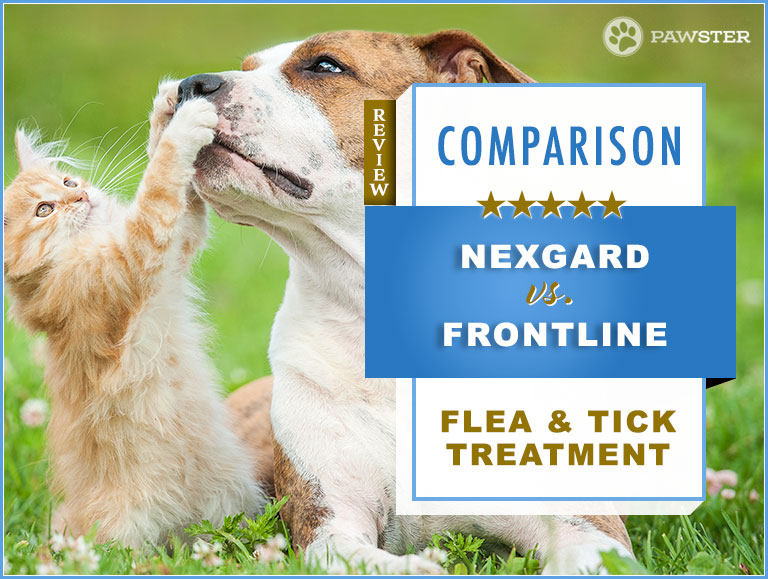NexGard vs. Frontline: Our 2024 In-Depth Comparison

Contents of Article
- Frontline Key Features
- NexGard Key Features
- What Are Fleas?
- What Are Ticks?
- How Do I Know If My Pet Has Fleas/Ticks?
- Are Flea & Tick Treatments Different for Cats & Dogs?
- Which is Better NexGard or Frontline for Dogs?
- Which is Better NexGard or Frontline for Cats?
- Our Review of NexGard and Frontline
- NexGard
- Frontline
- Key Differences Between NexGard and Frontline
- NexGard and Frontline Active Ingredients Comparison
- Which Treatment is the Best Priced?
- Which Do We Recommend?
- 7 Treatment Application Tips
- Conclusion
NexGard and Frontline are powerful, effective and vet approved flea and tick treatments for pets designed to root out and kill adult fleas and ticks, including their eggs and larvae.
Frontline flea and tick treatment is applied topically to your pet’s fur, and is safe for use on cats and dogs, which makes it an excellent treatment option for multi-pet families.
Frontline Key Features
- Designed for use on cats & dogs
- Delivered topically
- Eliminates, fleas, ticks + eggs and larvae
- Key ingredients: fipronil & methoprene
Frontline features two main ingredients; fipronil, designed to kill adult fleas and ticks, and methoprene, which destroys flea eggs and larvae.
NexGard Key Features
- Not designed for use on cats
- Delivered orally
- Eliminates, fleas, ticks + eggs and larvae
- Key ingredients: afoxolaner
NexGard, on the other hand, features afoxolaner which, unlike most other flea and tick treatments is designed to be delivered orally via a beef-flavored bite-sized chewable.
If your dog or cat is scratching and biting at their fur more than usual, and their skin is showing signs of irritation, then we are sorry to say that your pet may have fleas or a tick.
Also Read: Nexgard vs. Advantix
What Are Fleas?
The common flea or Ctenocephalides Canis is nearly a microscopic insect that feeds on the blood of dogs, cats, and even humans.
Fleas are easily contracted by dogs and cats whose fur can be infested by merely brushing up against another infested pet.
Pets can also bring fleas into your home where they can spread to infest the entire building.
What Are Ticks?
Dermacentor Variabilis, also known as a tick is a small blood-sucking menace similar to the flea, but much larger.
Ticks are commonly contracted in high brush environments like tall grass, and most outdoor environments.
Ticks latch on to your pet by digging their head beneath the skin where they feed on your pet’s blood if left untreated ticks will eventually reach their full of blood and fall off.
However, by the time that happens the tick may have already infected your pet, and possibly you a harmful disease, including:
- Lyme disease
- Rocky Mountain
- Spotted fever
- Ehrlichiosis
- Babesiosis
- Anaplasmosis,
- Tick paralysis.
How Do I Know If My Pet Has Fleas/Ticks?
Fleas and ticks are incredibly annoying to your pet and your life. In some cases, fleas and ticks are obvious, other times infestations can be exceptionally hard to detect.
Veterinarians recommend looking out for these symptoms:
Abnormal Scratching, Licking, and Biting
Fleas seek out and feed on your pet’s blood, as a food source. Once fleas have infested your pet, they reside in difficult to see places, such as the head, neck, tail, armpits, and groin.
Fleas are itchy. If your pet has contracted fleas, they will scratch lick and bite the flea-ridden areas incessantly.
Head Shaking
If you notice that your pet is frequently shaking its head, then a tick may have latched itself inside your pets’ ear canal.
If you suspect that a tick has crawled in your pets’ ear canal, you can check by shining a flashlight in your pet’s ear and looking for a black dot, approximately the size of a match head.
Abnormal Red, Puffy or Irritated Patches of Skin
Fleas and ticks irritate the skin, often causing large red patches, rashes, and lesions.
Hair/Fur Loss
Pets infested with fleas or ticks may begin to lose fur in the infested area due to excessive scratching and biting.
Pale Gums
Pale gums are a result of your pet’s body not producing a sufficient amount of new red blood cells to compensate for the loss of blood the fleas and ticks are extracting.
Pets exhibiting pale gums are suffering from a serious flea infestation and should be taken to the vet immediately.
Flea Dirt
Flea dirt is small black or reddish-brown specks on your pet’s body, and even in your home.
Flea dirt is actually flea feces, and it is a dead giveaway that your pet and your home are infested.
Fever
It is not uncommon for pets to run mild or high-grade fevers in the period shortly after contracting a tick.
Symptoms of fever in pets include weakness, loss of appetite, shivering and heavy panting.
Scabs & Bumps
If you feel a bump on your pet, it may be nothing, or it may be a tick. Any abnormal bump on your pet’s skin should be investigated.
Are Flea & Tick Treatments Different for Cats & Dogs?
Yes. Flea and tick treatments for dogs and cats can vary dramatically regarding active ingredient and prescribed dosage.
It is critically important that you consult with your veterinarian before administering any treatment to your pet.
If you suspect that your pet or you may have contracted fleas or a tick there is no need to worry, a simple application of a flea and tick treatment kills existing fleas and ticks, and prevents eggs from hatching to infest your pet’s coat.
Which is Better NexGard or Frontline for Dogs?
Overall, Frontline is the better flea and tick treatment for dogs. Frontline provides an effective combination of the insecticide fipronil and insect growth regulator called methoprene.
Together, fipronil and methoprene provide broad-spectrum protection and prevention against the entire flea life cycle including the egg and larval stages.
Frontline is very effective against ticks and typically require fewer applications/doses than flea-infested dogs treated with NexGard.
Additionally, Frontline is generally agreed to be slightly safer for small dogs than much of the competition.
Which is Better NexGard or Frontline for Cats?
Frontline is the better option for cats because NexGard is not designed, or intended for use on cats.
Our Review of NexGard and Frontline
NexGard
NexGard is a monthly flea and tick treatment strictly intended for use in dogs.
Contrary to the majority of flea and tick treatments that are applied topically to your pet’s skin, NexGard is designed to be administered orally.
NexGard comes in a beef-flavored chewable tablet containing the active ingredient afoxolaner. Afoxolaner is highly effective at killing adult fleas and ticks in every stage of their lifecycle.
Like most flea and tick treatments NexGard is administered monthly, in varying doses depending on the weight of the dog.
Overall, NexGard is effective at removing fleas and tick infestations, but it does not prevent new infestations from occurring.
However, NexGard is proven to kill 100% of fleas and ticks within the first 24 hours.
Frontline
Like NexGard, Frontline is a flea and tick treatment for dogs that eliminates flea and tick infestations within 24 hours.
However, unlike NexGard, Frontline is available for cats and dogs and is generally regarded as very effective for two reasons.
The first reason is Frontlines proven track record and reputation for speed and effectiveness. Frontline is applied topically and begins working in the first 12 hours, and kills ticks for up to 48 hours.
Frontline also eliminates chewing lice infestations and even assist in controlling sarcoptic mange.
The second reason Frontline works so well is due to its active ingredients, fipronil, and methoprene.
When combined in the topical treatment, fipronil and methoprene create a powerful barrier of protection and prevention for your pet against fleas, ticks, and lice in every stage of their life.
Key Differences Between NexGard and Frontline
The key differences between NexGard and Frontline are found in how the treatments are administered, and their active ingredients.
NexGard is administered via a beef-flavored chewable tablet containing the active ingredient afoxolaner.
In contrast, Frontline is administered via a topical treatment applied to the skin between your pets’ shoulder blades.
Frontline contains fipronil and methoprene and is cleared for use in dogs and cats, so long as the correct dosage is administered to the correct animal.
NexGard and Frontline Active Ingredients Comparison
NexGard contains afoxolaner as its active ingredient. Afoxolaner was developed to treat and prevent flea and tick infestations in dogs older than 8 weeks and weighing more than 4 pounds.
Afoxolaner is administered orally via beef-flavored tablets. Once in the dog’s bloodstream afoxolaner attacks the flea’s nervous system once it attempts to feed, killing it.
Frontline contains two active ingredients that combine to eradicate flea and tick infestations and prevent new ones from forming.
The first active ingredient in Frontline is fipronil. Fipronil is a broad-spectrum insecticide used to control ants, beetles, cockroaches, fleas, ticks, termites, and many other insects.
The second active ingredient in Frontline is methoprene. When utilized in conjunction with insecticide methoprene serves as growth regulator that stunts the lifecycle of eggs and larva, preventing them from hatching and prolonging the infestation.
Which Treatment is the Best Priced?
NexGard is the more affordable option when compared to Frontline.
- NexGard Chewable Tablets for Dogs, 10.1-24 lbs – $48.65
- Frontline Plus Flea & Tick Treatment for Small Dogs & Puppies 1- 22 lbs – $63.99
- NexGard Chewable Tablets for Dogs, 24.1-60 lbs – $48.65
- Frontline Plus Flea & Tick Treatment for Medium Dogs 23-44 lbs – $65.29
- NexGard Chewable Tablets for Dogs, 60.1-121 lbs – $51.79
- Frontline Plus Flea & Tick Treatment for Large Dogs 45-88 lbs – $66.59
Which Do We Recommend?
After a thorough examination of the merits and effectiveness of NexGard and Frontline, we feel confident recommending Frontline for flea and tick treatment on cats and dogs.
Though slightly more expensive than NexGard, Frontline is considered to be more effective, faster acting, and longer lasting than NexGard.
What’s more, NexGard cannot be used on cats, whereas Frontline manufactures Frontline Plus Flea & Tick Treatment for Cats & Kittens.
7 Treatment Application Tips
- Topical flea and tick treatments are typically applied via a syringe to the skin between your pets’ shoulder blades. This process is made easier by removing your pet’s collar.
- Topical flea and tick treatments work best when allowed to dry. For this reason, it is always a good idea to prevent your pet from swimming or getting wet for 24 hours after treatment application.
- If a topical flea and tick treatment is not a viable solution for your dog, then we recommend switching to a tablet treatment which is easily administered via feeding.
- Homes with more than one pet should administer flea and tick treatments to each animal to prevent the infestation from spreading. Be sure to administer a full dose to each animal.
- It is generally easier to apply topical flea and tick treatments when your pet is asleep and immobile.
- Flea and tick treatments are only effective when applied monthly. Be sure to keep up with applications to ensure the infestation does not return.
- Pet owners administering oral applications should be careful that the dog eats the entire dose. Dogs should be observed for several minutes after application to ensure that a picky puppy does not refuse the tablet.
Conclusion
NexGard and Frontline are both highly effective at treating flea and tick infestations, and we are confident recommending Frontline as the preferred flea and tick treatment when compared to Nexgard.
However, we are also confident recommending NexGard as the chewable alternative for topical flea and tick treatment.
Before choosing NexGard or Frontline for your pet, be sure to consult your veterinarian and to purchase the correct dosage for your pet.






